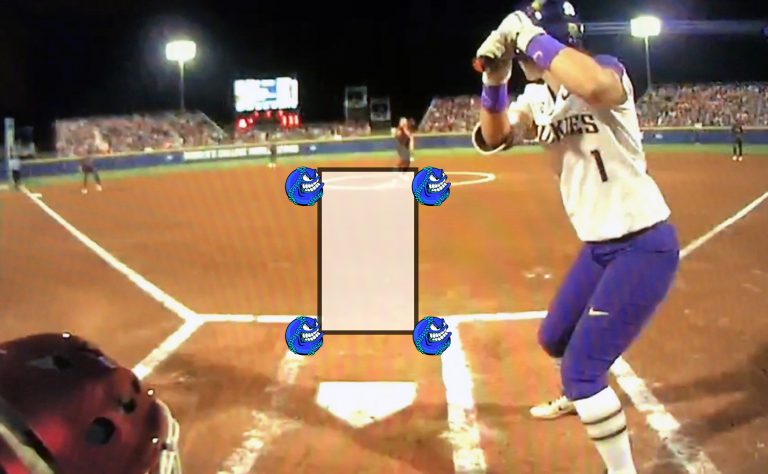
What’s the official strike zone for Fastpitch softball?
Forget the pitch-caller’s strike zone, the hitter’s strike zone, and even the pitcher’s strike zone. There’s only one strike zone that really matters, and you should recognize and learn it very early. Which zone is it? It’s the umpire’s strike zone, of course.
Officially, I’ll comment and say that based on major rule books, the strike zone is basically any part of the ball over the plate where the top of the strike zone is at the hitter’s sternum (in their regular batting stance) to the top of their knees. Over the plate means anything that crosses over the white or black of the plate (if it has a black outline). The zone I like best is when umpires give any part of the ball crossing any part of the plate or the knees, and then all of the ball is under the armpits, which is essentially again the sternum. And this is how most local umpires call the zone from 16u down. Nationally at the 18u level and into college, it seems all too often that the top of the zone gets skewed into the batters favor at the belly button or the belt.
What’s a fair strike zone for the pitcher?
I feel it’s very important for the umpires to give a fair strike zone. Technologies continue to advance on fastpitch bats, but no technology continues to advance for the pitcher. Down the middle is a bad choice for any pitcher. To have a strike zone where every part of the ball has to be inside every part of the plate and above the knees and below the sternum is not fair to the pitcher and quite frankly can be a bit dangerous to her. That kind of strike zone tends to be calling for far too much red; too much down the middle and too much at the belt.
When I’m most effective as a softball pitching coach and when I can have the most success with fastpitch pitching lessons is when I can teach girls to ‘paint’ the upper and lower corners of the strike zone, where only a minimum part of the ball breaks the corners of the upper and lower zone or plate, which result in a lot of backward K’s, hitters going down looking.

Keep up this amazing work! I enjoyed reading it
The plate Umpires, speaking as one, do not have the right to change the rules. They should always give their best when making the call. Occasionally, even a seasoned professional gets pitches ( often in the same game same pitcher and not intended) that are right on the line of his bottom, top etc..
Every body else gives their best on the pitch. Including the rest of the Umpire team! Why not the Umpire?
The “strike zone” is clearly defined in the particular rule book and dont vary amoung the different levels. Barring recreational/developmental leagues. Which can be the most challenging because of the mix of talent.
Look at the rules, images, and accept them. Most of all, umpires need to recognize their own ability. Concentrate on their profession. Thereby, the only legitimate complaint would be regarding his or her ability to recognize balls, strikes, safe or outs. It’s not easy. There is a lot more to umpiring that’s not so black and white. And I know most true fans know that. As such, they deserve only the best you can give in any game. For yourself ( umpires) do your best to get better.. by knowing your strengths and weaknesses.
Agree 100%. When I asked a couple of umpires what happened to calling strikes according to the rules, they said they get together before the season starts to decide the limits of the strike zone. Doesn’t matter what the rule book says, they’ll call anything above the belt a ball, taking away the most important part of the zone from a rise ball pitcher.
Shrinking the strike zone does nothing to develop new pitching prospects. I realize batters like to hit the ball, and to make it more fair for them let’s go back to the days when the pitcher’s trailing foot had to remain on or close to the rubber–no leaping. For those batters who are too proud to face getting a strikeout, go play slow pitch and leave fastpitch to the real men.
The top two are strikes, the bottom two are not. The top and bottom of the strike zone the ball must be entirely inside of the zone to be a strike. Inside and outside any pitch where any part of the ball crosses the plate it’s a strike. Now if your point is for pitcher’s to command the corners, then 100% I agree with you. I rarely call anything over the plate except when we’re facing the bottom of the order. Then I make them prove they can catch up to my pitcher’s…
Mastering the umpire’s strike zone is key in fastpitch softball. As a pitching coach, I focus on teaching pitchers to control the corners with precision, aiming for strategic strikeouts. It’s about skillfully navigating the zone for effective results on the mound.